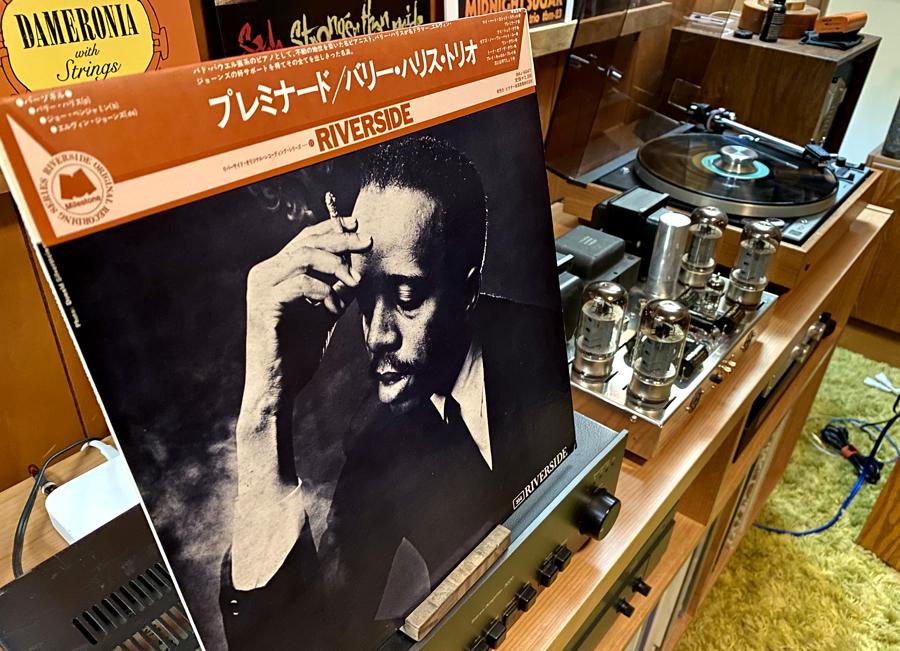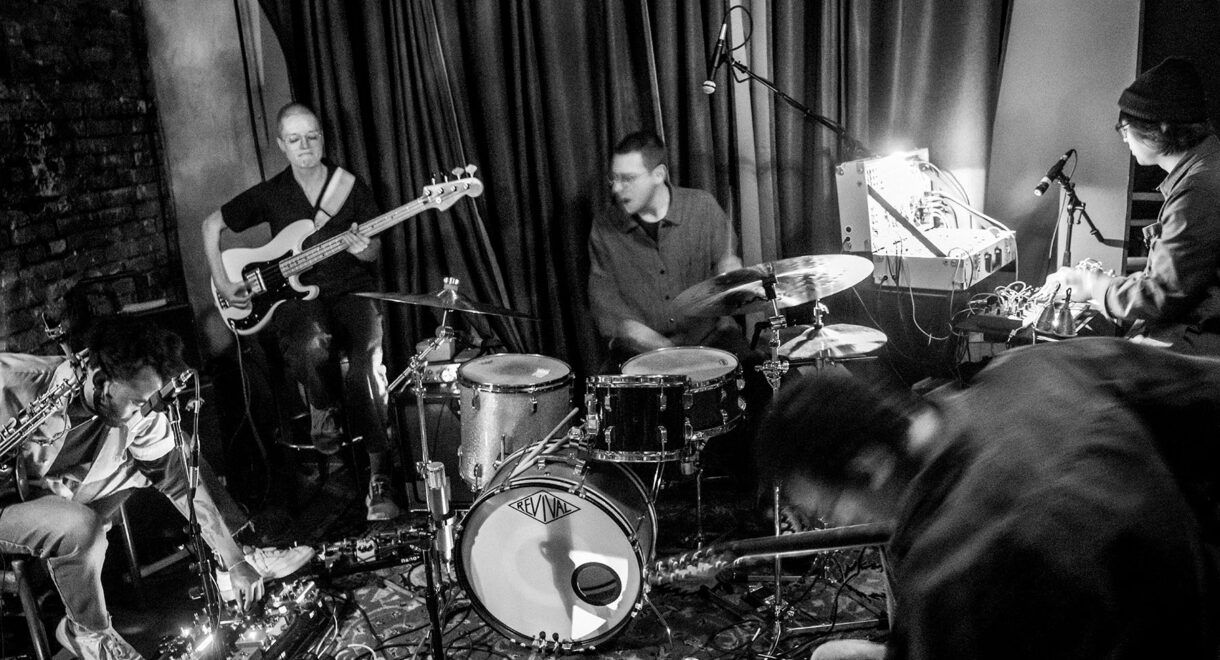Transparent clarity, deep bass, and “Invisible Sound” from German audio company ADS. Background: One of the lesser known hi-fi brands of the ’70s, ADS (Analog and Digital Systems) […]
Japanese Jazz Kissa and the Art of the Piano Trio: Exit to Vintage Street

“One night in a Japanese jazz kissa changed music listening for me forever.”
Every now and then, a listening session turns into something more. You lose yourself for a few minutes, or for a whole record side. You engage with the music. You float and drift amongst the notes and instruments. Time stops. Transcendent. This is what it’s all about. A better quality audio system takes this to another level, and my first experience in a jazz kissa in Japan changed everything for me.
The transcendent experience doesn’t happen all the time, but occurred a few evenings ago listening to Billy Taylor and his trio on the 1959 release, One for Fun. With Earl May on bass and Kenny Dennis on drums driving the rhythm on a tight and soulful outing. Perfect. It made me start to think about the piano trio sub-genre of jazz, and what made me fall in love with that combination.

Early in my jazz listening, I was drawn to the pyrotechnics of the trumpet and sax. Don’t get me wrong, I still love those instruments and groupings that include one or both, but there’s something about the trio. The most elemental, and intimate grouping. Just piano, bass and drums. Piano typically in the lead, but a far more democratic grouping than when the limelight-stealing brass are involved. Bass and drums with more to say in the musical dialogue, and greater soloing opportunities for these oft neglected instruments.
Lee Morgan can take the night off.
There are so many great pianists for listeners to explore; some well-known, and some flying under the radar. A list of the major artists should include: Bill Evans, Wynton Kelly, Red Garland, Chick Corea and Herbie Hancock, all famous for their work with Miles Davis, and for their own trio work. McCoy Tyner of John Coltrane’s famous quartet and Horace Silver of the Jazz Messengers, both leaders and creators of some of the most memorable music from the period. Sonny Clark, Thelonious Monk and Oscar Peterson; all known for their supporting roles on some of jazz’s greatest albums, and for their own projects as leaders.
And who can forget Dave Brubeck, Ahmad Jamal or Duke Ellington. Bud Powell probably belongs on this list as well. The Philadelphia-native recorded some beautiful albums over the course of his career with Charlie Parker and others; Jazz Giant is a must listen if you’ve never heard it and want a serious taste of his playing and compositional skills. A very underrated jazz pianist that you need to explore.

Now if you’re not a big reader, and you haven’t explored most of these artists yet, you can stop right now. Truth be told, you could build a substantial jazz collection on just Bill Evans’ and Oscar Peterson’s work as band leaders and sidemen. But dig and explore a little deeper and wider; you will discover that there are numerous other underappreciated jazz pianists to be found. This is where I’ve been playing of late, and I’ve been loving some of the relatively unknown but stellar pianists and recordings that I’ve dug up.
Two very distinct experiences spring-boarded my curiosity and have informed my ongoing piano trio explorations. First, in May 2019, my wife and I went to Japan for a few weeks to have a holiday and visit family and friends. Japan is a special place and there are aspects of it – from the perspective of the music listener – that we really don’t have here.
A secondary mission this trip was to visit as many Jazz kissas (jazz bars/coffee shops) as possible. The Japanese culture puts a great deal of importance on ceremony. To have a cup of tea at a kissaten (“tea-drinking shop”) while listening to jazz has been a part of Japanese culture since 1929, but the modern connection between kissa and tea is more tenuous. Kissa are more about coffee (which also became popular during the American occupation), because coffee and jazz together were seen as very western and exotic.
The Second World War had a profound impact on the jazz kissa movement; listening to American jazz music was obviously forbidden with the two countries engaged in warfare across the Pacific and it had to remain underground during the war years. American jazz artists became popular again in Japan in the 1950s and 1960s, but very few people could afford the prices of the records. That reality made the jazz kissa the only place that the average person could enjoy the music.
Our first night in Fukuoka, my wife met up with an old friend, so I headed out for some solo exploring and happened across a spot called Jazz Bar Browny. Arriving quite early (they had just opened, and the place was empty), I grabbed a seat at the bar and started chatting with the “master” (bartender and owner). He asked if I had any requests, and I suggested Duke Jordan’s Flight to Jordan.
On it went. Perfect for this setting and their superb system. They really do have a very different appreciation of music and jazz in Japan and I long for the day that I can experience something similar in Canada or the United States. It will never have the same atmosphere as the jazz kissas in Japan, but I think we need them. It might sound somewhat crazy (and even sad) to some, but jazz listeners in Japan will spend an entire day and evening listening to their favorite jazz recordings (both vinyl and CDs) in a jazz kissa. It serves as an opportunity to socialize, drink, and enjoy a lot of wonderful music on some excellent audio systems.
The Japanese do not have a lot of space. Certainly not the kind of space for the systems used in these jazz bars and coffee shops. The jazz kissa provides an opportunity to really experience music in a special way.

“One night in a Japanese jazz kissa changed music listening for me forever. My love for the jazz piano trio began in the most unique way possible.”
Duke and his crew sounded amazing, and at the end of the first side the master asked me for my top pianists. I mentioned some of the aforementioned artists. On reflection I wonder if he thought I was some ignorant westerner who read that list in a stereo magazine.
His gleeful response made me realize how lucky I was to be in that special moment.
“Tonight, I will teach you about my favourite jazz piano players!” he yelled across the bar which was starting to get busy.
And so began a procession of performers and records I’d never heard of. Some got played (and have since been added to my collection), and some only talked about, photographed and filed away for later reference.
That night changed music for me.

Billy Taylor – One for Fun (1959): The album that got me started on this article, and that I happily managed to track down just a few months ago. Taylor was not just a brilliant pianist and composer, but a jazz educator and promoter as well. Leonard Feather called him, indisputably “the world’s foremost spokesman for jazz.” He recorded prolifically in the ‘50s and ‘60s, but much of his discography is out of print and tough to find, particularly on vinyl. His swinging, bebop playing is elegant, crisp, brightly playful and inventive, and guaranteed to put a huge smile on your face.
Tsuyoshi Yamamoto – Night and Day Live at Misty (2014): Yamamoto is a Browny favorite and performs there regularly. He was self-taught (as far as jazz piano is concerned). In the 1970s, he was both the house pianist at Misty, a Tokyo jazz club for which this album was recorded for their 30th anniversary, and recorded prolifically by the renown Japanese jazz label, Three Blind Mice. His playing features energetic, funky syncopation, and a dominant right hand. Yamamoto gets an audience to move its feet.

Jack Wilson – Jack Wilson Quartet featuring Roy Ayers (1963): This was Wilson’s first album as leader, with Roy Ayers on vibes making this not a trio recording, but maintaining the democratic trio feel. Wilson’s playing has been knocked for being derivative, with comparisons drawn to Bud Powell and Horace Silver, but I’m no expert on that and truly enjoy his jaunty, bouncing, rhythmic style. I get predictive hints of Ryo Fukui (whom he predated) in some of his work, which is certainly nothing to complain about.
Michel Sardaby – Blue Sunset (1970): Sardaby hails from the island of Martinique in the Caribbean but moved to Paris in the ‘60s where he began his career, before settling in New York. Blue Sunset, recorded in Paris with Gilbert Rovere and Philippe Combelle, is a perfect late-night post-bop spin; warm, sophisticated, laid-back, and infused with a touch of the blues. It is easy to imagine that you’re in some dark piano bar just before closing. I’ve since found several more of his releases, and they share a similar vibe, with later albums featuring more of a Latin swing.
Other records pulled and not played that night were by Dick Morgan, Morris Nanton, Monty Alexander, Harold Mabern and Tete Montoliu. For some I’ve added records to the collection, and others still feature on the Discogs wish list, to be explored at a later date.
My second “trio experience” – more prolonged – took place on our return to Canada in June. With curiosity aroused, I looked further into Japanese jazz artists; and pianists in particular. This brought me back full circle to my first brushes with jazz 25+ years earlier. Over and over, I came across Ryo Fukui, the godfather of Japanese jazz piano (or at least the most famous jazz pianist outside Japan). I ordered a copy of Scenery, his 1976 debut, and from the cover image and further reading about his origins, connected the dots to my time living in Sapporo in the early ‘90s and listening to him play live on Wednesday nights.

Following the breadcrumbs and reading more about Fukui, led me to Barry Harris, another performer-educator cited as one of his biggest influences and best friends. He wasn’t a performer that I was familiar with, but I soon realized that I needed to learn more about him as he’d accompanied the likes of Art Farmer, Donald Byrd, Dexter Gordon, Hank Mobley, Thad Jones and Lee Morgan on some of my favourite records. Preminado and The Last Time I Saw Paris soon joined the growing piano trio collection of albums at home.

Further investigation of Japanese jazz piano stars brought Toshiko Akiyoshi to my attention, discovered playing in Ginza by a touring Oscar Peterson in 1953. He brought her to the attention of Verve’s Norman Granz, and off she went into the world of famous jazz artists.
Akiyoshi was well known in the United States in the ‘50s and ‘60s for her small ensemble work (as leader and with first husband, Charlie Mariano), and in the ‘70s for her big band work with second husband, Lew Tabackin. What makes her work distinctive is the inclusion of Japanese melodies and themes (and sometimes instruments), while always staying true to jazz sensibilities. Her 1978 release, Finesse, is a beautiful trio recording.

And so for me the jazz piano journey continues, with diversions and further discoveries to be made (if you have suggestions, message me at @audioloveyyc). I know I’ve missed a slew of other fine pianists here, including Tommy Flanagan, Horace Parlan, Duke Pearson, Kenny Drew, and more. Mentioned or ignored, all the artists appearing in this article are worthy of a listen. A return to Japan to enjoy music at my favorite jazz kissa is long overdue.

I hope I’ve sparked some interest here in a rich and enjoyable jazz style. If I have, you’re in for a real treat as you work your way through some of these artists. And if you’re feeling overwhelmed wondering where to start, blindfold yourself and throw darts; you can’t go wrong.
This article originally appeared at ecoustics.com and has been published here with permission.










